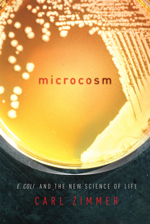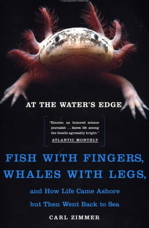July 1, 2008
Category: General
Okay--after some technical difficulties I won't bore you by recounting, I have an announcement. For the third time in this blog's life, I'm packing it up and moving it to a new home.
I would like offer my deepest thanks to Scienceblogs for hosting the Loom for two years. I got to know a great community of bloggers whom I will continue to follow closely as they flood my RSS stream. Virginia Hughes, Katherine Sharpe, Tim Murtaugh, and the rest of the folks behind the scenes at Scienceblogs have been wonderful to work with, always ready to get me out of whatever programming mess I fall into while never trying to control the content of the blog.
I'm moving the Loom because I'm starting a new incarnation as a columnist for Discover. Each month I'll be writing a column about the science at the intersection of brain and mind. Along with my column, I'll be joining some other excellent bloggers on Discover's web site, including Phil Plait at Bad Astronomy.
The new incarnation of the Loom will still contain its four-year archive of everything you've read before. And I will continue to blog the same disheveled mix of natural history, parasitic lore, evolutionary biology, and whatever else I find intriguing at the moment.
So goodbye, and hello.
Posted by Carl Zimmer at 9:00 AM •
June 30, 2008
Category: General
Really, it's not like I've discovered a new element or anything. See you tomorrow.
Posted by Carl Zimmer at 11:22 PM •
Category: General
...to spill beans. Any minute now, honest.
Posted by Carl Zimmer at 5:06 PM •
Category: General
...at 5 today. [That's 5 pm EST--sorry for the confusion.]
[Hint...I've turned off the comments till then.]
Posted by Carl Zimmer at 1:12 AM • 3 Comments
June 28, 2008
Category: The Parasite Files
 I'm sure you'd like to pretend that you have nothing in common with a tapeworm.
I'm sure you'd like to pretend that you have nothing in common with a tapeworm.
A tapeworm starts off as an egg which then develops into a cyst. Inside the cyst is a ball-shaped creature with hooks that it can use to crawl around its host before growing into an adult. Many species are made up of dozens or hundreds of segments called proglottids. Each proglottid may be equipped with both eggs and sperm-making organs. As an adult, a tapeworm also grows a head-like end often equipped with suckers or hooks of its own. This strange organ is called the scolex. (The shark tapeworm in this photo is displaying its fearsome scolex.) While the tapeworm lives in the gut of its host, it uses its scolex to clamp down in place, although it may swim around to find an ideal spot from time to time.
And from time to time, a proglottid breaks off from the body of the tapeworm and ends up leaving the body. Actually, it can leave under its own steam. Proglottids have muscles and nerves that they can use to crawl out the back end and along the ground.
Tapeworms evolved from free-living flatworms, but they have undergone some radical changes. Along with the evolution of their proglottids, they also abandoned their digestive tract, opting instead to slurp up their food directly through their skin. They're so weird now that scientists haven't even been sure which end is which. Some people have suggested the scolex is the head of the tapeworm. But others have pointed out that while the tapeworm is still in its cyst, the hooks actually form on the other end of its body. What's more, in related flatworms with recognizable heads and tails, the sperm-organs are closer to the head than the ovaries. In tapeworms, the ovaries are closer to the scolex.
This morning at the second day of the American Society of Parasitologists, Peter Olson from the Natural History Museum in London, offered a potential solution to the puzzle. All animals--including us--use a set of master genes to determine the head-to-tail anatomy of developing embryos. The precise DNA sequence of these genes is different from species to species, but they show clear evidence of having evolved from a set of genes in a distant ancestor. Scientists have carried out most of their research on these genes in well-studied species like fruit flies and mice. Only recently have scientists started to look at how these so-called Hox genes work in other animals. Olson is studying the genes in tapeworms that live in mice, called Hymenolepis.
One key gene Olson described is called Post-2. It corresponds to genes that defines the tail end of insects and mammals. When tapeworms develop into little balls with hooks, Olson has discovered, Post-2 becomes active on the end of the ball with the hooks. That suggests that the hooks are growing at the tail-end of the animal, before it has yet grown a tail.
Later, when the tapeworm develops into an adult with proglottids, Post-2 becomes active at one end of each segment. It becomes active at the end furthest from the scolex. So the tail end of the animal appears to be pointing away from the scolex--in other words, the scolex really is the head after all. It may not be a head you're familiar with--sans teeth, sans eyes, sans taste, although not quite sans everything. But when the tapeworm grew its head, it knew where it was the same way you knew when you grew yours.
[Edited a bit to address questions from commenters.]
Posted by Carl Zimmer at 11:36 PM • 5 Comments
Category: Microcosm: The Book
Science writer Peter Dizikes reviews my book Microcosm for the New York Times. It's great to see that he gets it--i.e., he understands what I'm trying to do with E. coli in the book. I actually appreciate that more than a positive review. Fortunately, he liked the book, too, calling it engrossing, vivid, and adroit. Check it out.
Posted by Carl Zimmer at 1:22 PM • 3 Comments
Category: General
 I'm back on bloggingheads.tv, talking this week with Paul Ehrlich about everything from climate change to Polynesian canoe oars to the origins of human culture to why cars are best for teenagers to make out in. Check it out.
I'm back on bloggingheads.tv, talking this week with Paul Ehrlich about everything from climate change to Polynesian canoe oars to the origins of human culture to why cars are best for teenagers to make out in. Check it out.
Posted by Carl Zimmer at 9:00 AM • 1 Comments
June 27, 2008
Category: The Parasite Files
 It feels like a homecoming: I'm among hundreds of people who live for parasites.
It feels like a homecoming: I'm among hundreds of people who live for parasites.
I arrived in Arlington Texas this afternoon to attend the annual meeting of the American Society of Parasitologists. I'm going to give a talk tomorrow about the public awareness of parasitology, talking about my long-term relationship with the beasties in books, articles, blogs, and beyond. But till then, I get to hang out with parasitologists. I've met a lot of the people here over the years, like the leech-master Mark Siddall, and I've read the work of a lot of people I'm just meeting (work on things like how lice jumped from gorillas to human ancestors).
And I'm also hearing new people talking about research I've never heard before--"nice and weird," as one parasitologist described the species she studies. I heard about a parasite in Nebraska, a flatworm called a trematode (Halipegus eccentricus), that scientists discovered living in the ears of bullfrogs. But the trematodes in their ears are all adults. Matt Bolek from the University of Nebraska described how he and his colleagues had figured out the rest of the parasite's life cycle. The parasites release their eggs from the frog ears, which then get scarfed up by snails, where they hatch and start to develop. Then they leave the snails and swim in search of little aquatic invertebrates called ostracods. The ostracods get eaten by the larvae of damselflies, which then mature and fly into the air, only to be devoured by frogs. The parasites escape the damselflies and move through the bodies of the frogs to their ears. One trematode, four hosts.
And you thought your commute was long.
Tomorrow I'll blog about more of these marvelous beasts.
[Image courtesy of Matthew Gilligan]
[Update: In answer to commenters--that's an invertebrate known as a isopod that's eaten the fish's tongue and is now sitting where the tongue used to be. Nice and weird, baby.]
Posted by Carl Zimmer at 6:51 PM • 4 Comments
June 26, 2008
Category: Evolution

In 1980, Walter Alvarez, a geologist at the University of California, Berkeley, and his colleagues proposed that the dinosaurs had been exterminated by an asteroid that smashed into the Earth. I was fourteen at the time, and that mix of dinosaurs, asteroids, and apocalyptic explosions was impossible to resist. I can still see the pictures that appeared in magazines and books--paintings of crooked rocks crashing into Earth, sometimes seen from the heavens, sometimes from the point of view of an about-to-become-extinct dinosaur. Suddenly the history of life was more cinematic than any science fiction movie.
By luck rather than foresight, I eventually became a science writer. I had the good fortune to start the job in the early 1990s, as the impact story was still unfolding. Until then, I knew Walter Alvarez only as a name on a page. Now I could call Alvarez and talk to him about new evidence other scientists were finding to support his impact hypothesis--evidence showing not only that the impact did come at the end of the Cretaceous period, but even revealing where it hit: a site called Chixculub, along the coast of the Yucatán Peninsula. "It ties everything together," Alvarez told me with delight in 1991. I had the wonderful privilege of watching the story continue to develop--as a bull's-eye ring a hundred miles across came to light under the Gulf of Mexico, as a piece of the asteroid itself was fished from the Pacific.
By 1997, the story had matured enough that Alvarez himself was ready to offer a firsthand account in T. rex and the Crater of Doom. It is an intimately readable look at how great science gets done. Scientists notice odd things that seem out of place, they contemplate ludicrous hypotheses, and then they doggedly test those hypotheses for years. T. rex and the Crater of Doom illustrates an important rule about science: some of the most revealing discoveries come not from deep within a single discipline, but at the borders between disciplines. The impact hypothesis would probably have come to nothing if not for the combined efforts of experts on everything from geochronology to pollen fossils to nuclear explosions.
That's the beginning of my foreword to Princeton University Library's new edition of Alvarez's book. I've posted the entire introduction here.
Posted by Carl Zimmer at 12:38 PM • 5 Comments
June 25, 2008
Category: Upcoming Talks
I'm bound for LA today to talk about Microcosm. My talk is part of the Zocalo lecture series. I'll be talking tonight at 7:30 pm at the Skirball Cultural Center. Here are the details.
Posted by Carl Zimmer at 5:38 AM •













 It feels like a homecoming: I'm among hundreds of people who live for parasites.
It feels like a homecoming: I'm among hundreds of people who live for parasites.


